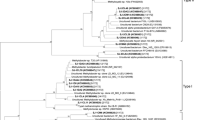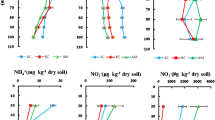Abstract
Methanogen populations of an intertidal mudflat in the Yangtze River estuary of China were investigated based on the methyl coenzyme M reductase A (mcrA) gene using 454-pyrosequencing and quantitative real-time polymerase chain reaction (qPCR). Samples were collected at six depths from three locations. In the qPCR analyses, a mean depth-wise change of mcrA gene abundance was observed from (1.23 ± 0.13)×107 to (1.16 ± 0.29)×108 per g dried soil, which was inversely correlated with the depletion of sulfate (R 2 =0.74; α = 0.05) and salinity (R 2 = 0.66; α = 0.05). The copy numbers of mcrA was at least 1 order of magnitude higher than dissimilatory sulfate reductase B (dsrB) genes, likely indicating the importance of methanogenesis at the mudflat. Sequences related to the orders Methanomicrobiales, Methanosarcinales, Methanobacteriales, Methanococcales and the uncultured methanogens; Rice Cluster I (RC-I), Zoige cluster I (ZC-I) and anaerobic methane oxidizing archaeal lineage-1 (ANME-1) were detected. Methanomicrobiales and Methanosarcinales dominated the entire sediment layers, but detectable changes of proportions were observed with depth. The hydrogenotrophic methanogens Methanomicrobiales slightly increased with depth while Methanosarcinales showed the reverse. Chao1 and ACE richness estimators revealed higher diversity of methanogens near the surface (0–10 cm) when compared with the bottom sediments. The near-surface sediments were mainly dominated by the family Methanosarcinaceae (45 %), which has members that can utilize substrates that cannot be used by sulfate-reducing bacteria. Overall, current data indicate that Methanosarcinales and Methanomicrobiales are the most dominant methanogens within the entire depth profile down to 100 cm, with higher abundance and diversity of methanogens in the deeper and upper sediment layers, respectively.






Similar content being viewed by others
References
Jickells T, Rae J (1997) Biogeochemistry of intertidal sediments. Cambridge University Press, Cambridge, pp 1–15
Thornton SF, McManus J (1994) Application of organic carbon and nitrogen stable isotope and C/N ratios as source indicators of organic matter provenance in estuarine systems: evidence from the tay estuary, scotland. Estuarine Coastal Shelf Sci 38:219–233. doi:10.1006/ecss.1994.1015
Cook PLM, Butler ECV, Eyre BD (2004) Carbon and nitrogen cycling on intertidal mudflats of a temperate Australian estuary: I. Benthic metabolism Mar Ecol Prog Ser 280:25–38
Middelburg JJ, Klaver G, Nieuwenhuize J, Vlug T (1995) Carbon and nitrogen cycling in intertidal sediments near doel, scheldt estuary. Hydrobiologia 311:57–69
Lipschultz F (1981) Methane release from a brackish intertidal salt-marsh embayment of chesapeake Bay, maryland. Estuaries 4:143–145
Middelburg JJ, Nieuwenhuize J, Iversen N, Høgh N, de Wilde H, Helder W, Seifert R, Christof O (2002) Methane distribution in european tidal estuaries. Biogeochem 59:95–119
Reebwgh WS (1969) Observations of gases in chesapeak bay sediments. Limnol Oceanogr 14:368–375
Wang D, Chen Z, Sun W, Hu B, Xu S (2009) Methane and nitrous oxide concentration and emission flux of yangtze delta plain river net. Science in China (SerB) 52:652–661
Chen H, Wang D, Chen Z, Wang J, Xu S (2005) The variation of sediments organic carbon content in chongming east tidal flat during scirpus mariqueter growing stage. J Geogr Sci 15:500–508
Nedwell DB, Embley TM, Purdy KJ (2004) Sulphate reduction, methanogenesis and phylogenetics of the sulphate reducing bacterial communities along an estuarine gradient. Aqua Microb Ecol 37:209–217
Senior E, Lindstrom EB, Banat IM, Nedwell DB (1982) Sulfate reduction and methanogenesis in the sediment of a saltmarsh on the east coast of the united kingdom. Appl Environ Microbiol 43:987–996
Waldron PJ, Petsch ST, Martini AM, Nüslein K (2007) Salinity constraints on subsurface archaeal diversity and methanogenesis in sedimentary rock rich in organic matter. Appl Environ Microbiol 73:4171–4179. doi:10.1128/AEM.02810-06
Winfrey MR, Ward DM (1983) Substrates for sulfate reduction and methane production in intertidal sediments. Appl Environ Microbiol 45:193–199
Rs O, Polcin S (1982) Methanogenesis and sulfate reduction: competitive and noncompetitive substrates in estuarine sediments. Appl Environ Microbiol 44:1270–1276
Winfrey MR, Zeikus JG (1977) Effect of sulfate on carbon and electron flow during microbial methanogenesis in freshwater sediments. Appl Environ Microbiol 33:275–281
Kaku N, AtsukoUeki KU, Watanabe K (2005) Methanogenesis as an important terminal electron accepting process in estuarine sediment at the mouth of orikasa river. Microbes Environ 1:41–52
Singh N (2005) Isolation and characterization of methylotrophic methanogens from anoxic marine sediments in skan Bay, alaska: description of methanococcoides alaskense sp. nov., and emended description of methanosarcina baltica. Int J Syst Evol Microbiol 55:2531–2538. doi:10.1099/ijs.0.63886-0
Biddle JF, Cardman Z, Mendlovitz H, Albert DB, Lloyd KG, Boetius A, Teske A (2011) Anaerobic oxidation of methane at different temperature regimes in guaymas basin hydrothermal sediments. ISME J 6:1018–1031. doi:10.1038/ismej.2011.164
Parkes RJ, Brock F, Banning N, Hornibrook ERC, Roussel EG, Weightman AJ, Fry JC (2012) Changes in methanogenic substrate utilization and communities with depth in a salt-marsh, creek sediment in southern england. Estuar Coast Shelf Sci 96:170–178. doi:10.1016/j.ecss.2011.10.025
Mori K, Iino T, Suzuki KI, Yamaguchi K, Kamagata Y (2012) Aceticlastic and NaCl-requiring methanogen "methanosaeta pelagica" sp. nov., isolated from marine tidal flat sediment. Appl Environ Microbiol 78:3416–3423. doi:10.1128/aem.07484-11
King GM, Klug MJ, Lovley DR (1983) Metabolism of acetate, methanol, and methylated amines in intertidal sediments of lowes cove, maine. Appl Environ Microbiol 45:1848–1853
Friedrich MW (2005) Methyl-coenzyme M reductase genes: unique functional markers for methanogenic and anaerobic methane-oxidizing archaea. Method Enzymol 397:428–442. doi:10.1016/S0076-6879(05)97026-2
Luton PE, Wayne JM, Sharp RJ, Riley PW (2002) The mcrA gene as an alternative to 16S rRNA in the phylogenetic analysis of methanogen populations in landfill. Microbiol 148:3521–3530
Antony CP, Colin Murrell J, Shouche YS (2012) Molecular diversity of methanogens and identification of methanolobus sp. As active methylotrophic archaea in lonar crater lake sediments. FEMS Microbiol Ecol 81:43–51. doi:doi:10.1111/j.1574-6941.2011.01274.x
Lueders T, Chin K-J, Conrad R, Friedrich M (2001) Molecular analyses of methyl-coenzyme M reductase a-subunit (mcrA) genes in rice field soil and enrichment cultures reveal the methanogenic phenotype of a novel archaeal lineage. Environ Microbiol 3:194–204
Zhang T, Ye L, Hin A, Tong Y, Shao M-F, Lok S (2011) Ammonia-oxidizing archaea and ammonia-oxidizing bacteria in six full-scale wastewater treatment bioreactors. Appl Microbiol Biotechnol 91:1215–1225. doi:10.1007/s00253-011-3408-y
Luke C, Frenzel P (2011) Potential of pmoA amplicon pyrosequencing for methanotroph diversity studies. Appl Environ Microbiol 77:6305–6309. doi:10.1128/AEM.05355-11
Oakley BB, Carbonero F, Dowd SE, Hawkins RJ, Purdy KJ (2012) Contrasting patterns of niche partitioning between two anaerobic terminal oxidizers of organic matter. ISME J 6:905–914. doi:10.1038/ismej.2011.165
Zhang H (2011) Using pyrosequencing and quantitative PCR to analyze microbial communities. Front Environ Sci Eng 5:21–27. doi:10.1007/s11783-011-0303-9
Berry D, Ben Mahfoudh K, Wagner M, Loy A (2011) Barcoded primers used in multiplex amplicon pyrosequencing bias amplification. Appl Environ Microbiol 77:7846–7849. doi:10.1128/AEM.05220-11
Steinberg LM, Regan JM (2009) McrA-targeted real-time quantitative PCR method to examine methanogen communities. Appl Environ Microbiol 75:4435–4442. doi:doi:10.1128/AEM.02858-08
Schloss PD, Westcott SL, Ryabin T, Hall JR, Hartmann M, Hollister EB, Lesniewski RA, Oakley BB, Parks DH, Robinson CJ, Sahl JW, Stres B, Thallinger GG, Horn DJV, Weber CF (2009) Introducing mothur: open-source, platform-independent, community-supported software for describing and comparing microbial communities. Appl Environ Microbiol 75:7537–7541. doi:10.1128/AEM.01541-09
Steinberg LM, Regan JM (2008) Phylogenetic comparison of the methanogenic communities from an acidic, oligotrophic fen and an anaerobic digester treating municipal wastewater sludge. Appl Environ Microbiol 74:6663–6671. doi:10.1128/AEM.00553-08
Lozupone C, Knight R (2005) UniFrac: a new phylogenetic method for comparing microbial communities. Appl Environ Microbiol 71:8228–8235. doi:10.1128/AEM.71.12.8228-8235.2005
Sowers KR, Baron SF, Ferry JG (1984) Methanosarcina acetivorans sp. nov., an acetotrophic methane-producing bacterium isolated from marine sediments. Appl Environ Microbiol 47:971–978
Castro H, Ogram A, Reddy KR (2004) Phylogenetic characterization of methanogenic assemblages in eutrophic and oligotrophic areas of the florida everglades. Appl Environ Microbiol 70:6559–6568. doi:10.1128/AEM.70.11.6559-6568.2004
Zhang G, Tian J, Jiang N, Guo X, Wang Y, Dong X (2008) Methanogen community in zoige wetland of tibetan plateau and phenotypic characterization of a dominant uncultured methanogen cluster ZC-I. Environ Microbiol 10:1850–1860. doi:10.1111/j.1462-2920.2008.01606.x
Imachi H, Sakai S, Sekiguchi Y, Hanada S, Kamagata Y, Ohashi A, Harada H (2008) Methanolinea tarda gen. nov., a methane producing archaeon isolated from a methanogenic digester sludge. Int J Syst Evol Microbiol 59:294–301. doi:10.1099/ijs.0.65394-0
Patel GB, Sprott GD (1990) Methanosaeta concilii gen. nov. sp. nov. (“Methanothrix concilii”) and methanosaeta thermoacetophila nom. rev., comb. nov. Int J Syst Bacteriol 40:79–82. doi:10.1099/00207713-40-1-79
Colwell FS, Boyd S, Delwiche ME, Reed DW, Phelps TJ, Newby DT (2008) Estimates of biogenic methane production rates in deep marine sediments at hydrate ridge, cascadia margin. Appl Environ Microbiol 74:3444–3452. doi:10.1128/AEM.02114-07
Jiang L, Zheng Y, Chen J, Xiao X, Wang F (2011) Stratification of archaeal communities in shallow sediments of the pearl river estuary, southern china. Antonie van Leeuwenhoek 99:739–751. doi:10.1007/s10482-011-9548-3
Kurr M, Huber R, Kionig H, Jannasch HW, Fricke H, Trineone A, Kristjansson JK, Stetter KO (1991) Methanopyrus kandleri, gen. And sp. nov. Represents a novel group of hyperthermophilic methanogens, growing at 110°C. Arch Microbiol 156:239–247. doi:doi:030289339100125J
Lovley DR, Dwyer DF, Klug MJ (1982) Kinetic analysis of competition between sulfate reducers and methanogens for hydrogen in sedimentst. Appl Environ Microbiol 43:1373–1379. doi:0099-2240/82/061373-07$02.00/0
Schink B, Zeikus JG (1982) Microbial ecology of pectin decomposition in anoxic lake sediments. J Gen Microbiol 128:393–404
Kiene RP, Oremland RS, Catena A, Laurence MG, Capone DG (1986) Metabolism of reduced methylated sulfur compounds in anaerobic sediments and by a pure culture of an estuarine methanogen. Appl Environ Microbiol 52:1037–1045. doi:0099-2240/86/111037-09$02.00/0
Schink B, Zeikus JG (1980) Microbial methanol formation: a major end product of pectin metabolism. Curr Microbiol 4:387–389
Summons RE, Franzmann PD, Nichols PD (1998) Carbon isotopic fractionation associated with methylotrophic methanogenesis. Org Geochem 28:465–475
Leloup J, Petit F, Boust D, Deloffre J, Bally G, Clarisse O, Quillet L (2005) Dynamics of sulfate-reducing microorganisms (dsrAB genes) in two contrasting mudflats of the seine estuary (france). Microb Ecol 50:307–314. doi:10.1007/s00248-004-0034-6
Wilms R, Sass H, Kӧpke B, Jr K, Cypionka H, Engelen B (2006) Specific bacterial, archaeal, and eukaryotic communitiesin tidal-flat sediments along a vertical profile of several meters. Appl Environ Microbiol 72:2756–2764. doi:10.1128/AEM.72.4.2756-2764.2006
Wellsbury P, Parkes RJ (1995) Acetate bioavailability and turnover in an estuarine sediment. FEMS Microbiol Ecol 17:85–94
Jetten MSM, Stams AJM, Zehnder AJB (1992) Methanogenesis from acetate: a comparison of the acetate metabolism in methanothrix soehngenii and methanosarcina spp. FEMS Microbiol Rev 88:181–198
Geets J, Borremans B, Diels L, Springael D, Vangronsveld J, van der Lelie D, Vanbroekhoven K (2006) DsrB gene-based DGGE for community and diversity surveys of sulfate-reducing bacteria. J Microbiol Methods 66:194–205. doi:10.1016/j.mimet.2005.11.002
Leloup J, Loy A, Knab NJ, Borowski C, Wagner M, Jørgensen BB (2007) Diversity and abundance of sulfate-reducing microorganisms in the sulfate and methane zones of a marine sediment, black Sea. Environ Microbiol 9:131–142. doi:10.1111/j.1462-2920.2006.01122.x
Acknowledgments
This project was partly supported by the National Natural Science Foundation of China (31070097 and 30930019), National Key Technology R&D Program of China (2010BAK69B14) and Major Program of Science and Technology Department of Shanghai (10DZ1200700).
Author information
Authors and Affiliations
Corresponding author
Electronic supplementary material
Below is the link to the electronic supplementary material.
ESM 1
(DOC 603 kb)
Rights and permissions
About this article
Cite this article
Zeleke, J., Lu, SL., Wang, JG. et al. Methyl Coenzyme M Reductase A (mcrA) Gene-Based Investigation of Methanogens in the Mudflat Sediments of Yangtze River Estuary, China. Microb Ecol 66, 257–267 (2013). https://doi.org/10.1007/s00248-012-0155-2
Received:
Accepted:
Published:
Issue Date:
DOI: https://doi.org/10.1007/s00248-012-0155-2




